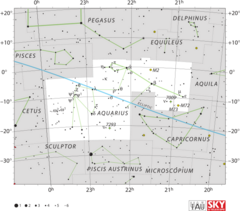Astronomy:Tau1 Aquarii
| Observation data Equinox J2000.0]] (ICRS) | |
|---|---|
| Constellation | Aquarius |
| Right ascension | 22h 47m 42.76996s[1] |
| Declination | –14° 03′ 23.1419″[1] |
| Apparent magnitude (V) | +5.66[2] |
| Characteristics | |
| Spectral type | B9 V[3] |
| U−B color index | –0.25[4] |
| B−V color index | –0.05[4] |
| Astrometry | |
| Radial velocity (Rv) | +15[5] km/s |
| Proper motion (μ) | RA: +29.960[1] mas/yr Dec.: –9.009[1] mas/yr |
| Parallax (π) | 9.1849 ± 0.1301[1] mas |
| Distance | 355 ± 5 ly (109 ± 2 pc) |
| Absolute magnitude (MV) | +0.74[6] |
| Details | |
| Mass | 2.68±0.05[7] M☉ |
| Radius | 2.0[8] R☉ |
| Luminosity | 63.5[7] L☉ |
| Temperature | 10,617[7] K |
| Rotational velocity (v sin i) | 185[7] km/s |
| Age | 100[9] Myr |
| Other designations | |
| Database references | |
| SIMBAD | data |
Tau1 Aquarii, Latinized from τ1 Aquarii, is the Bayer designation for a single[11] star in the equatorial constellation of Aquarius. With an apparent visual magnitude of 5.66,[2] it is a faint naked eye that requires dark suburban skies for viewing. Parallax measurements made during the Hipparcos mission yield a distance estimate of roughly 355 light-years (109 parsecs) from Earth.[1] The star is drifting further away with a radial velocity of +15 km/s.[5] It is a candidate member of the Pisces-Eridanus stellar stream.[12]
The stellar classification of τ1 Aquarii is B9 V;[3] right along the borderline between a B- and A-type main sequence star. This is a candidate silicon star; a type of Ap star of class CP2 that shows a magnetic field.[13] It is around 100[9] million years old and is spinning rapidly with a projected rotational velocity of 185 km/s.[7] The star has 2.7[7] times the mass of the Sun and double the Sun's radius.[8] It is radiating 63.5[7] times the luminosity of the Sun from its photosphere at an effective temperature of 10,617 K.[7] When examined in the infrared band, it displays an excess emission that is a characteristic of stars with an orbiting debris disk. The model that best fits the data suggests there are two concentric circumstellar disks.[9]
References
- ↑ 1.0 1.1 1.2 1.3 1.4 1.5 Brown, A. G. A. (August 2018). "Gaia Data Release 2: Summary of the contents and survey properties". Astronomy & Astrophysics 616: A1. doi:10.1051/0004-6361/201833051. Bibcode: 2018A&A...616A...1G. Gaia DR2 record for this source at VizieR.
- ↑ 2.0 2.1 Corben, P. M.; Stoy, R. H. (1968), "Photoelectric Magnitudes and Colours for Bright Southern Stars", Monthly Notes of the Astronomical Society of Southern Africa 27: 11, Bibcode: 1968MNSSA..27...11C.
- ↑ 3.0 3.1 Houk, Nancy (1978), Michigan catalogue of two-dimensional spectral types for the HD stars, 4, Ann Arbor: Dept. of Astronomy, University of Michigan, Bibcode: 1988mcts.book.....H.
- ↑ 4.0 4.1 Nicolet, B. (1978), "Photoelectric photometric Catalogue of homogeneous measurements in the UBV System", Astronomy and Astrophysics Supplement Series 34: 1–49, Bibcode: 1978A&AS...34....1N.
- ↑ 5.0 5.1 Wilson, Ralph Elmer (1953), "General catalogue of stellar radial velocities", Carnegie Institute Washington D.C. Publication (Carnegie Institution of Washington), Bibcode: 1953GCRV..C......0W.
- ↑ Anderson, E.; Francis, Ch. (2012), "XHIP: An extended hipparcos compilation", Astronomy Letters 38 (5): 331, doi:10.1134/S1063773712050015, Bibcode: 2012AstL...38..331A.
- ↑ 7.0 7.1 7.2 7.3 7.4 7.5 7.6 7.7 Zorec, J.; Royer, F. (2012), "Rotational velocities of A-type stars. IV. Evolution of rotational velocities", Astronomy & Astrophysics 537: A120, doi:10.1051/0004-6361/201117691, Bibcode: 2012A&A...537A.120Z.
- ↑ 8.0 8.1 Pasinetti Fracassini, L. E. et al. (February 2001), "Catalogue of Apparent Diameters and Absolute Radii of Stars (CADARS) - Third edition - Comments and statistics", Astronomy and Astrophysics 367 (2): 521–524, doi:10.1051/0004-6361:20000451, Bibcode: 2001A&A...367..521P.
- ↑ 9.0 9.1 9.2 Morales, Farisa Y. et al. (April 2011), "Common Warm Dust Temperatures Around Main-sequence Stars", The Astrophysical Journal Letters 730 (2): L29, doi:10.1088/2041-8205/730/2/L29, Bibcode: 2011ApJ...730L..29M, https://authors.library.caltech.edu/24736/1/Morales2011p15446Astrophys_J_Lett.pdf.
- ↑ "* tau01 Aqr". SIMBAD. Centre de données astronomiques de Strasbourg. http://simbad.u-strasbg.fr/simbad/sim-basic?Ident=%2A+tau01+Aqr.
- ↑ Eggleton, P. P.; Tokovinin, A. A. (September 2008), "A catalogue of multiplicity among bright stellar systems", Monthly Notices of the Royal Astronomical Society 389 (2): 869–879, doi:10.1111/j.1365-2966.2008.13596.x, Bibcode: 2008MNRAS.389..869E.
- ↑ Curtis, Jason L. et al. (August 2019), "TESS Reveals that the Nearby Pisces-Eridanus Stellar Stream is only 120 Myr Old", The Astronomical Journal 158 (2): 11, doi:10.3847/1538-3881/ab2899, 77, Bibcode: 2019AJ....158...77C.
- ↑ Wraight, K. T. et al. (2012), "A photometric study of chemically peculiar stars with the STEREO satellites - I. Magnetic chemically peculiar stars★", Monthly Notices of the Royal Astronomical Society 420 (1): 757–772, doi:10.1111/j.1365-2966.2011.20090.x, Bibcode: 2012MNRAS.420..757W.
External links
 |


